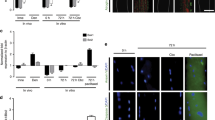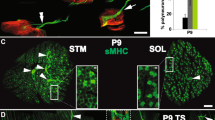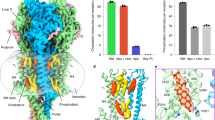Abstract
A FOREIGN motor nerve transplanted on to an adult innervated muscle will not form functional neuromuscular synapses1, yet several experimental procedures, such as denervation or muscle crush, change the properties of the muscle membrane so that a foreign nerve can establish ‘ectopic’ synapses in a normally endplate-free region of the muscle2–4. The nerve thereby induces a localised area of high acetylcholine receptor (AChR) density in the extrajunctional membrane5. Denervated or previously crushed muscle fibres already have, before synapse formation, low density AChRs in the extrajunctional membrane6,7. The extrajunctional AChRs are different in a number of respects from those in the junctional membrane8–11. The question is, therefore, whether the AChRs of an ectopic synapse have properties similar to junctional or to extrajunctional AChRs.
This is a preview of subscription content, access via your institution
Access options
Subscribe to this journal
Receive 51 print issues and online access
$199.00 per year
only $3.90 per issue
Buy this article
- Purchase on Springer Link
- Instant access to full article PDF
Prices may be subject to local taxes which are calculated during checkout
Similar content being viewed by others
References
Elsberg, C. A. Science 45, 318–320 (1917).
Fex, S. & Thesleff, S. Life Sci. 6, 635–638 (1967).
Miledi, R. Nature 193, 281–282 (1962).
Miledi, R. Nature 199, 1191–1192 (1963).
Lomo, T. & Slater, C. R. J. Physiol., Lond. 258, 107 P (1976).
Miledi, R. J. Physiol., Lond. 151, 24–30 (1960).
Katz, B. & Miledi, R. J. Physiol., Lond. 170, 389–396 (1964).
Berg, D. K. & Hall, Z. W. Science 184, 473–475 (1974).
Chang, C. C. & Huang, M. C. Nature 253, 643–644 (1975).
Beranek, R. & Vyskocil, F. J. Physiol., Lond. 188, 53–66 (1976).
Katz, B. & Miledi, R. J. Physiol., Lond. 224, 665–699 (1972).
Neher, E. & Sakmann, B. J. Physiol., Lond. 258, 705–730 (1976).
Dreyer, F., Walther, Chr. & Peper, K. Pflügers Arch. ges. Physiol. 366 1–9 (1976).
Sakmann, B. Pflügers Arch. ges. Physiol. 359, R89 (1975).
Anderson, C. R. & Stevens, C. F. J. Physiol., Lond. 235, 655–691 (1973).
Sytkowski, A. J., Vogel, Z. & Nirenberg, M. W. Proc. natn. Acad. Sci. U.S.A. 70, 270–274 (1973).
Ko, P. K., Anderson, M. J. & Cohen, M. W. Science 196, 540–542 (1977).
Colquhoun, D., Dionne, V. E., Steinbach, J. H. & Stevens, C. F. Nature 253, 204–206 (1975).
Mallart, A., Dreyer, F. & Peper, K. Pflügers Arch. ges. Physiol. 362, 43–47 (1976).
Stevens, C. F. Biophys. J. 12, 1028–1047 (1972).
Karnovsky, M. J. J. Cell Biol. 23, 217–222 (1964).
Gage, P. W. & McBurney, R. N. J. Physiol., Lond. 244, 385–407 (1975).
Hartzell, H. C., Kuffler, S. W. & Yoshikami, D. J. Physiol., Lond. 251, 427–463 (1975).
Anderson, M. J. & Cohen, M. W. J. Physiol., Lond. 268, 751–773 (1977).
Author information
Authors and Affiliations
Rights and permissions
About this article
Cite this article
BRENNER, H., SAKMANN, B. Gating properties of acetycholine receptor in newly formed neuromuscular synapses. Nature 271, 366–368 (1978). https://doi.org/10.1038/271366a0
Received:
Accepted:
Published:
Issue Date:
DOI: https://doi.org/10.1038/271366a0
This article is cited by
-
Brachial plexus injuries Guidelines for management: Our experience
The Italian Journal of Neurological Sciences (1994)
-
Change in synaptic channel gating during neuromuscular development
Nature (1978)
Comments
By submitting a comment you agree to abide by our Terms and Community Guidelines. If you find something abusive or that does not comply with our terms or guidelines please flag it as inappropriate.



